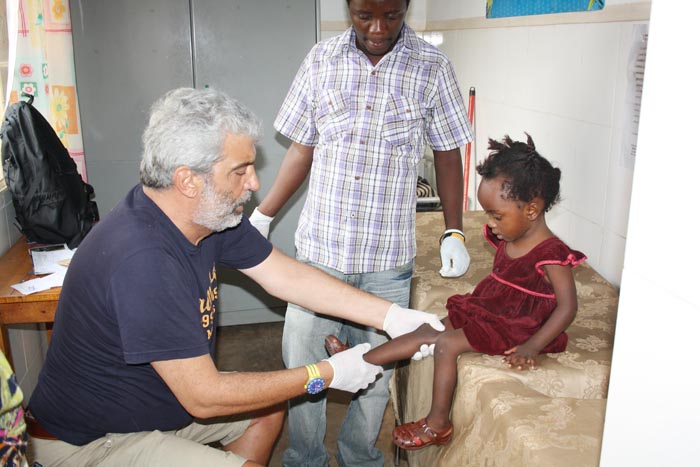On January 15th 2014, a team of Italian Orthopedists were at Kamenge for their first day of consultation. The 72 lucky children who will be found eligible for surgery will go to Bubanza for a free reconstructive surgery.-By Joanna Nganda
It’s 10 a.m. and Kamenge’s Mirango Health Center is already crowded. In the waiting room, nearly a hundred children accompanied by their mothers are waiting, patiently. Most of the children have limb deformities and some, probably unaware that the doctors are only there for limb surgeries, had facial abnormalities and painful looking ulcers. While Doctor Emanuele Delianni was busy examining his first patient, an 18 month-old little girl with severely crooked legs, the Resident Doctor Lorenzo de Sanctis was telling us more about their mission in Burundi “we are here for anyone with orthopaedic problems, but we do naturally favor the poorest children, with the most serious cases.” The Orthopedists are humanitarian volunteers, “we paid for our own tickets from Italy to Burundi. We also brought our instruments,” says Cosimo Tudisco, Professor at the University of Rome, “we work at Bubanza Hospital and we will be in Burundi for about 3 weeks. All 3 of us belong to an association called FIMAC.” FIMAC, the International Foundation of Doctors for Central Africa, is a non-profit organization created by Professor Vincenzo Monti, 83 years old, who spent over 20 years in Burundi and has been running a local hospital in Bubanza since 2000. FIMAC will take full charge of all surgery medical costs.
Fears and hopes
Nkurunziza Claudine, the mother of 7 years old Ndayishimiye Yvonne, expresses her fears and hopes.
“Yvonne is 7, I am afraid they might think she is too old for the surgery. In the past years, other doctors told me that the only option for Yvonne was to be sent abroad for surgery; in Burundi no one could perform it. But we can’t send her abroad, we don’t have money. Today, I am anxious to meet the Italian doctors…hopefully, they will tell me Yvonne will be going to Bubanza for surgery,” says Claudine, while looking at her little girl sitting in a wheel chair. Yvonne’s legs and arms are atrophied, and her articulations seem to be in the wrong places. Her mysterious condition started to be visible 2 weeks after her birth and has been worsening ever since. “You know, Yvonne is intelligent; she is doing well mentally and intellectually. Her disabilities are only physical. In fact, she goes to school like any other child. The problem is that when you hold her, her fragile bones get dislocated or can even break, and it takes a month or two for her to recover,” states Claudine. “During that time she can’t go to school because of pain, and she regresses. Without school, Yvonne will never make it socially and financially. I don’t want her to be a person with disabilities and financial problems adding insult to injury,” Claudine concludes.
Lorenzo De Sanctis allows a glimpse of hope, “We know many Burundian children need medical care, we will do as much as we can for now and contact FIMAC to see if we can do more than 72 surgeries.” That hope is an uncertain possibility, but uncertainty is the bearer of hope.















 IWACU Open Data
IWACU Open Data

